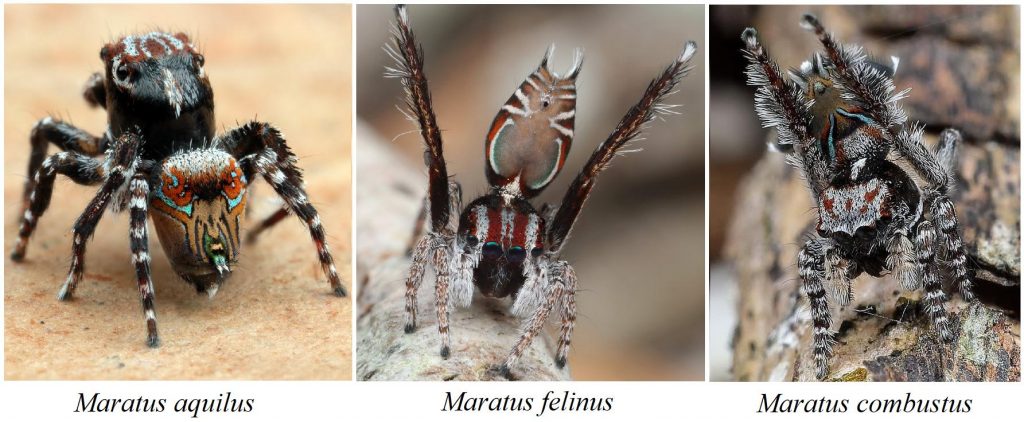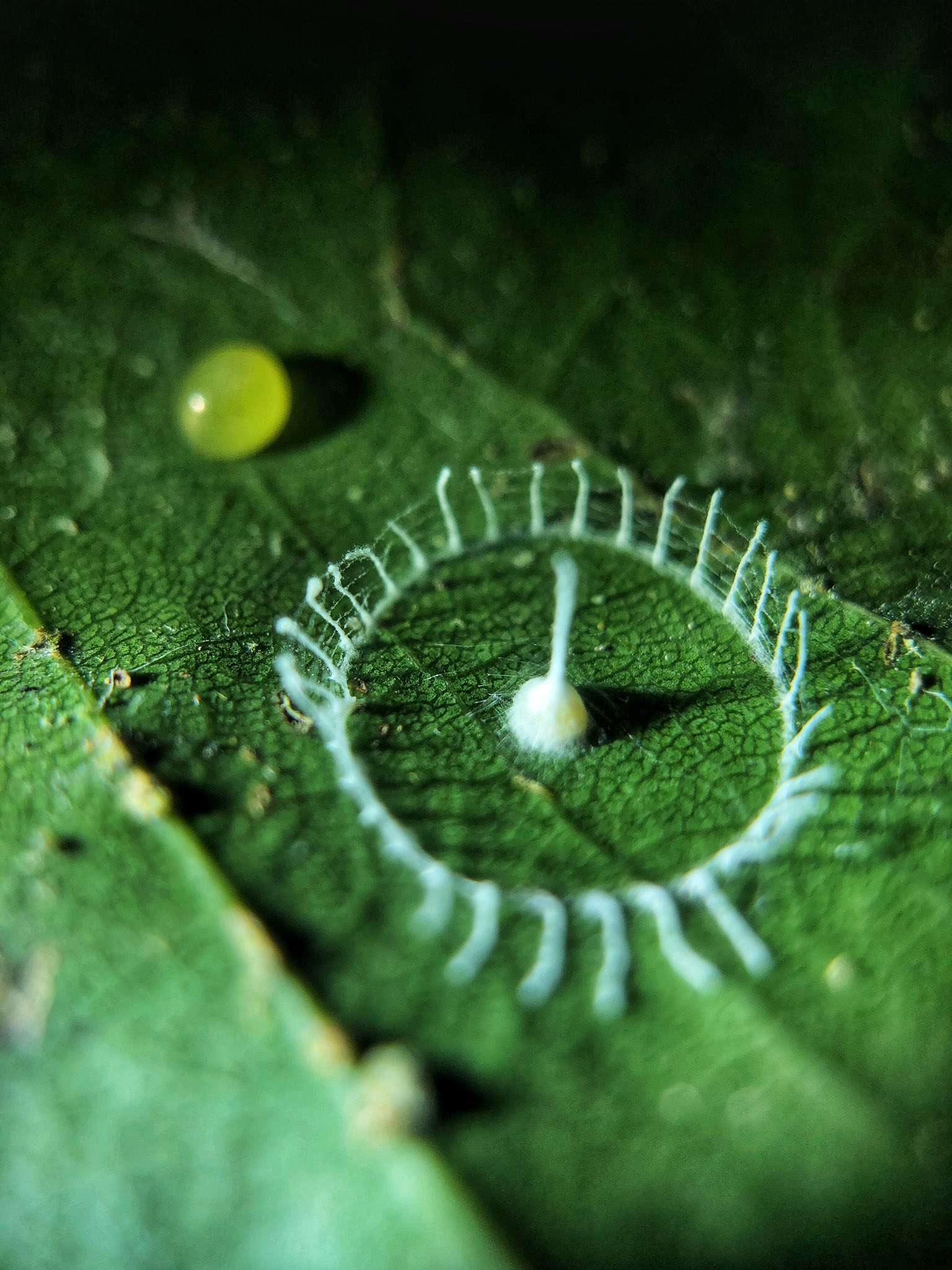Featured image: “silkhenge” spider nest in Tambopata, Peru, by Phil Torres.
This month: new peacock spiders, a new ZeFrank video, some really unique hunting and feeding behaviours observed, tips for spider-hunters, and more.
Art and education
- ZeFrank makes a glorious return with True Facts about the Bolas Spider. Both accurate and hilarious. My favourite line: “chatting up a piece of pigeon shit for two hours”.
https://www.youtu.be/watch?v=9qw3lkpa5lY
- Here’s a great video demystifying white-tail spiders (family Lamponidae), which really don’t deserve their bad reputation.
https://www.youtu.be/watch?v=cc8nMAuBqS0
- I absolutely love this pixel art graphic of the different arachnid orders by @ni075. It’s part of a thread on that horseshoe crab paper from last month.
せっかく描いたので、学名(+英語名)も一斉に並んでみます。
一部のクモやサソリでないクモガタ類の英語名に spider や scorpion がついたせいで、英語界隈におけると誤解を招きやすいものになる。また、「ダニ」に対応する英語名は存在せず、tick(マダニ)とmite(他のダニ)として区別される。 pic.twitter.com/9oAurUmH6L— Jun (@ni075) March 3, 2019
- The Guardian lists “the world’s nine most beautiful spiders”. I have a lot of quibbles with this list, but I guess I’ll take this over yet another piece calling spiders “creepy”.
Dispatches
- On Twitter, Alex Wild says that “every entomologist worthy of a public position” should be able to explain why they kill the insects they love for collections. Thomisid taxonomist Joseph T. Lapp shares a lovely “pre-sacrifice recitation”:
Thank you for allowing me to meet you. You are beautiful, and I want to share your beauty with others, to teach people to care for your kind. To do that, we have to know what to call you. May your sacrifice benefit not only your kind, but also all spiders and the humans who learn to love them.
- I’ve been following biologist and blogger PZ Myers since Usenet days. He’s recently switched from studying zebrafish to spiders, and it’s been a very interesting journey (with a steep learning curve). Here’s his latest vlog on the Parasteatoda tepidariorum he’s raising.
-
@Tone_Killick describes what a spider hunter needs in their field kit. (See also Sean McCann’s electric toothbrush spider lures.)
Research and observations
- The Jungle Diaries’ Phil Torres is back in the Peruvian Amazon, and he’s found more “silkhenges”!
Look what we found! First night out in Tambopata and my first silkhenge sighting in 3 years. pic.twitter.com/hbzYZTSLkd
— Phil Torres (@phil_torres) March 5, 2019
- We’ve all seen orb-weaving spiders taking advantage of bright artificial lights at night. How does this affect the spiders? Is the increased haul worth the physiological side-effects, and what could the long-term consequences be for urban ecosystems? This paper from a team at the University of Melbourne provides some preliminary investigations. [Paper.]
-
This paper from researchers at the University of Western Ontario combines two of my favourite things: red velvet mites, and the question of how bugs outlast harsh Canadian winters. Yes, these mites can survive being frozen at -20°C! [Paper.]
-
There’s a lot of research on the colour preferences of vertebrate predators like birds, but only a few papers for another group of smart visual hunters—jumping spiders! Do jumping spiders like the Floridian Habronattus brunneus learn to avoid red-coloured prey? In a different environment, would they react differently? [Paper.]
-
The jumping spider Telamonia dimidiata is common throughout Southeast Asia, but misinformation and ignorance is rife, says Javed Ahmed. That’s what compelled him and his co-authors to document their observations in a short article for Peckhamia. [Paper.]
-
In the newsletter of the British Arachnological Society, Chris Cathrine describes male hacklemesh weavers (Amaurobius similis) feeding on mushed banana in his kitchen. Spiders feeding on sugary stuff from plants has been widely observed, but this would seem to be the first documented case from the Amaurobiidae family. The best bit:
[The author] would also like to thank his children, Logan and Ross Cathrine, for leaving pieces of mushed banana out on his kitchen table.
[Paper.]
- Speaking of spiders eating plant matter, here’s an extremely tense video of a spider feeding on nectar on a Venus flytrap without triggering the hairs that cause the plant to snap shut!
LIVING ON THE EDGE! There are few reports of spiders feeding on nectar but this is possibly a first. A spider getting an easy meal by feeding on the nectar secreted by the Venus’ Flytrap. It survived.. this time! #PlantsWithBite #nature #spiders @NatGeo @austmus #WildOz #wildlife pic.twitter.com/6tREJ0GWXB
— Greg Bourke (@GregBourke3) March 10, 2019
- The slingshot spider’s hunting method is truly unique: it weaves an orb web, then pulls it back taut with a thread at the centre. When prey comes near, the spider releases the thread, hurling itself and the web forward. And according to Symone Alexander and colleagues at Georgia Tech, it moves faster than any other spider. And its acceleration puts the cheetah to shame!
- Okay, so this story on ant-mimicking spider courtship and communication, out of Morehouse Lab, is from February, but I love ant-mimicking spiders so much, I can’t pass it up.
New species
- A new genus of bald-legged spiders (family Tropididae) from Colombia has been named Stormtropis after the stormtroopers in Star Wars. Why? “These soldiers are very similar to each other, with some capacity for camouflage but with unskillful movements, like this group of spiders.” [Paper.]
-
Non-profit citizen science group Project Maratus has discovered three new colourful, charismatic peacock jumping spiders from Western Australia. Maratus aquilus’s markings resemble an eagle’s face; M. combustus has a flame-coloured abdomen; and M. felinus’s tufted abdomen looks oddly like a cat. I was personally hoping for the last one to be named M. pusheeni. [Paper.]

Events
- The Royal Botanical Gardens (Hamilton/Burlington, ON) is hosting the exhibit Spiders Alive! until April 14. There are events and programs for all ages, and also a very exciting tarantula livestream.
https://www.youtu.be/watch?v=mhqvhRWFA2A
Thank you for reading! Corrections and suggestions welcome.
